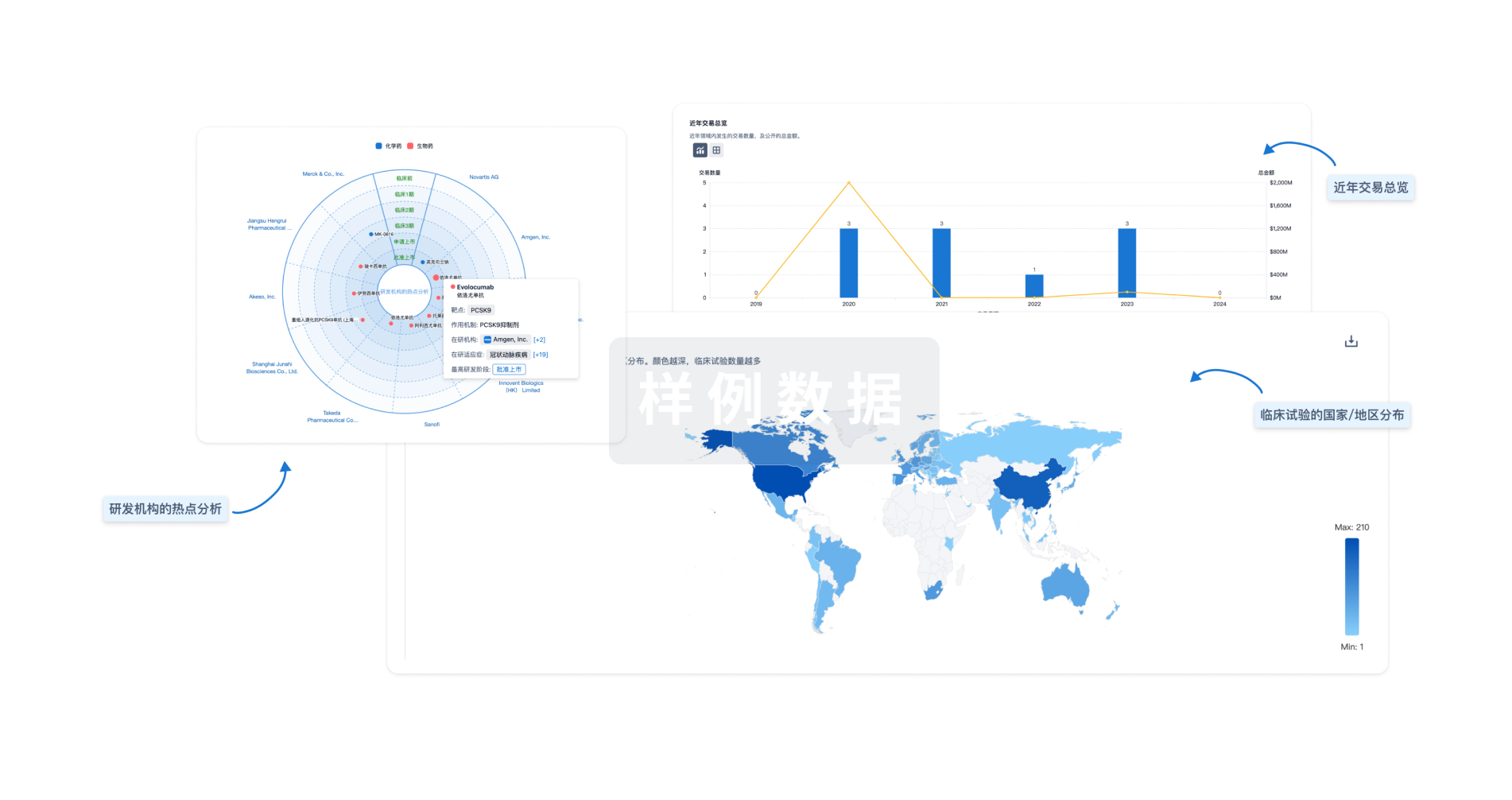预约演示
更新于:2025-05-07
VCAM1 x α4β1
更新于:2025-05-07
关联
100 项与 VCAM1 x α4β1 相关的临床结果
登录后查看更多信息
100 项与 VCAM1 x α4β1 相关的转化医学
登录后查看更多信息
0 项与 VCAM1 x α4β1 相关的专利(医药)
登录后查看更多信息
1,003
项与 VCAM1 x α4β1 相关的文献(医药)2025-01-22·ACS Applied Materials & Interfaces
DNA Aptamer-Polymer Conjugates for Selective Targeting of Integrin α4β1+ T-Lineage Cancers
Article
作者: Cheng, Emmeline L. ; Wu, Abe Y. ; Nguyen, Dinh Chuong ; Cardle, Ian I. ; Pun, Suzie H. ; Kacherovsky, Nataly ; Sellers, Drew L. ; Wang, Tong ; Salipante, Stephen J. ; Jensen, Michael C. ; Pichon, Trey J. ; Raman, Jai
2024-10-01·Leukemia
The VLA-4 integrin is constitutively active in circulating chronic lymphocytic leukemia cells via BCR autonomous signaling: a novel anchor-independent mechanism exploiting soluble blood-borne ligands
Article
作者: Olivieri, Jacopo ; Hartmann, Tanja Nicole ; Nicolò, Antonella ; Capasso, Guido ; Nanni, Paola ; Moia, Riccardo ; Pozzo, Federico ; Ianna, Giulia ; Zaja, Francesco ; Rossi, Davide ; Del Principe, Maria Ilaria ; Cattarossi, Ilaria ; Rossi, Francesca Maria ; Gentile, Massimo ; Maity, Palash C ; Gaglio, Annalisa ; Tissino, Erika ; Chiarenza, Annalisa ; Laureana, Roberta ; Del Poeta, Giovanni ; Gaidano, Gianluca ; Zucchetto, Antonella ; Jumaa, Hassan ; Forestieri, Gabriela ; Zimbo, Anna Maria ; Zaina, Eva ; Datta, Moumita ; Laurenti, Luca ; Härzschel, Andrea ; Palumbo, Giuseppe A ; Bomben, Riccardo ; D'Arena, Giovanni ; Martino, Enrica Antonia ; Bittolo, Tamara ; Gattei, Valter
2024-08-06·Journal of Crohn's and Colitis
Blocking GPR15 Counteracts Integrin-dependent T Cell Gut Homing in Vivo
Article
作者: Neurath, Markus F ; Atreya, Raja ; Schramm, Sebastian ; Zundler, Sebastian ; Dietz, Lisa ; Saad, Marek ; Liu, Li-Juan ; Voskens, Caroline J ; Dedden, Mark ; Müller, Tanja M ; Atreya, Imke
4
项与 VCAM1 x α4β1 相关的新闻(医药)2024-10-30
·赞Med
点击上方“蓝字”关注我们吧!
呼吸道合胞病毒(RSV)是儿童急性呼吸道感染的主要病因之一,暴露于包括香烟烟雾、颗粒物、苯、臭氧(O3)、一氧化碳(CO)或二氧化氮(NO2)在内的空气污染则可能增加RSV发病率和严重程度。世界卫生组织(WHO)已公布六种最重要的空气污染物清单,包括颗粒物≤直径10μm的颗粒物(PM10)、直径在0.1至2.5μm之间的颗粒物(PM2.5)、NO2、O3、二氧化硫(SO2)和CO。
目前关于RSV和空气污染的确切病理机制数据较少,主要结论集中在宿主抗病毒能力下降、促进病毒进入和病毒载量增加、病毒从主要感染细胞释放增加、炎症反应延长和/或加重(可能导致组织病理改变,粘液分泌增强和气道高反应(AHR)),其中最重要的共同机制之一似乎由氧化应激所介导。
N-乙酰半胱氨酸(NAC)作为一种具有抗氧化和抗炎特性的粘液溶解药物,已广泛应用于慢性阻塞性肺疾病(COPD)、支气管扩张症、特发性肺纤维化等临床研究中。一篇发布在《International Journal of Molecular Sciences》(IF=4.9)的系统综述回顾现有文献以确定NAC在治疗RSV感染和空气污染中的分子作用机制[1]。
研究设计
研究者对Scopus、PubMed(Medline)和Cochrane数据库进行了系统的文献检索,检索数据库中1998年至2023年9月7日期间所有分析NAC在RSV感染或空气污染中的分子作用机制的原始研究。共检索出167项研究,去重后,根据摘要和标题排除了122项研究,阅读全文最后筛选出28项原始研究纳入系统综述。
研究结果
NAC可减少病毒进入
空气污染主要通过两种机制促进病毒进入:
(1)损伤保护屏障(由于现有屏障受损或存在额外的运输通道);
(2)病毒吸附增加(由于细胞表面的变化促进病毒粘附,或RSV获得特殊毒力,从而促进其粘附到细胞表面或进入),但暂未发现关于RSV毒力增加的信息(图1)。
①NAC可改善上皮屏障通透性
Smallcombe等人在人支气管上皮细胞和小鼠模型中证明,TiO2-NP通过破坏顶端连接复合物(AJC)和重塑细胞内细胞骨架肌动蛋白对AJC的锚定以增强RSV诱导的上皮屏障瓦解,使上皮变得“渗漏”,从而增强病毒感染。通过评估病毒降低滴度,NAC治疗减少了AJC分解,改善了上皮通透性,降低了RSV感染程度。
氧化应激在其中扮演着不容忽视的作用,研究发现共暴露于RSV和TiO2-NP后细胞内活性氧(ROS)水平迅速增加,并保持高水平长达36小时;Wen等人的研究证实暴露于TiO2-NP后过氧化氢酶(CAT)活性增加,ROS上调,许多细胞间隙和内皮层通透性增加,内皮钙黏蛋白(VE-cadherin)表达降低,而NAC的使用逆转了氧化应激和间隙的形成,表明其在氧化应激中发挥关键作用。
②NAC可抑制血清细胞间粘附分子1(ICAM-1)表达
ICAM-1是一种存在于多种细胞表面的糖蛋白,包括上皮细胞和内皮细胞、淋巴细胞和单核细胞,RSV感染诱导人内皮细胞上ICAM-1表达呈时间和剂量依赖性过度增加。
Mata等研究表明,在RSV培养的原代正常人支气管上皮细胞(NHBEC)中,使用NAC预处理可消除ICAM-1表达增加现象;Modestou等人发现香烟烟雾提取物抑制干扰素-γ(IFN-γ)诱导的人器官支气管上皮细胞(hTBE)中ICAM-1的表达,但NAC和谷胱甘肽单乙基酯(GSH-MEE)能够减轻这种抑制作用。
除ICAM-1外,空气污染还可能诱导其他表面分子表达:TiO2-NP诱导内皮细胞中ICAM-1、血管细胞间黏附分子1(VCAM-1)、血小板内皮细胞黏附分子(PECAM-1)和选择素(E和P)的表达,以及它们在单核细胞上的配体包括早期[E-选择素配体(sLex)和P-选择素配体(PSGL-1)]和晚期粘附分子[ICAM-1配体(LFA-1)、VCAM-1配体(VLA-4)和PECAM-1配体(αVβ3)]的受体表达,而NAC可抑制表面受体的表达。
③NAC可阻断表皮生长因子受体(EGFR)磷酸化
RSV进入细胞的另一种机制涉及EGFR的磷酸化和激活以及与EGFR相关信号因子的级联反应(PI3K、PKC、Cdc42、PAK1和N-Wasp)。RSV与细胞表面结合即激活EGFR的磷酸化及其下游信号级联,通过微胞饮作用引起肌动蛋白重排和内吞。NAC可阻断人支气管上皮细胞(HBECS)中EGFR的磷酸化,从而阻止病毒的内吞作用并减少感染。
NAC可抑制病毒载量增加
病毒载量增加可能源于宿主抗病毒反应降低、感染开始后RSV释放加速(通过促进从主要感染细胞释放)或由于RSV获得异常毒力(图2)。
①NAC可恢复抗病毒反应
人T细胞和自然杀伤(NK)细胞具有产生IFN-γ的能力,IFN-γ与其受体结合,并通过磷酸化Stat1导致Janus激酶/信号转导和转录激活因子(JAK/STAT)通路激活,二聚磷酸化的Stat1随后易位到细胞核并激活抗病毒基因。香烟烟雾提取物(CSE)抑制Stat1的磷酸化,并抑制IFN-γ介导的RSV mRNA和RSV蛋白表达降低,而使用NAC或GSH-MEE可恢复IFN-γ的抗病毒作用。
②NAC可抑制病毒释放
在暴露于CSE和RSV的hTBE细胞中观察到较高的病毒载量似乎与香烟烟雾可能阻止RSV诱导的caspase激活有关。在受CSE和RSV侵袭的细胞中,坏死比凋亡更明显,这导致病毒从感染细胞中释放出来,而不是凋亡。
一系列实验表明,使用NAC和醛脱氢酶能够部分逆转上皮细胞从凋亡到坏死的转变,这表明ROS和丙烯醛在这一复杂系统中发挥了重要作用。细胞模型显示,无香烟烟雾暴露的RSV也会产生ROS,并激活蛋白激酶/哺乳动物雷帕霉素靶点(AMPK-MTOR)信号通路,从而诱导自噬,促进病毒感染。敲除自噬基因(如beclin1)或用AMPK抑制剂(化合物C)或NAC治疗能够抑制RSV复制,但化合物C仅能阻断自噬依赖性RSV复制,NAC则具有抑制自噬依赖性和自噬非依赖性途径的能力。
Zhou等人的研究将细胞凋亡标志物的评估与临床角度相结合,在126例老年慢性阻塞性肺疾病(COPD)患者中采用口服NAC、吸入硫酸特布他林和两者联合三种治疗方法。所有治疗方案均可降低Fas受体/凋亡抗原1(Fas/APO-1)和可溶性Fas(sFas)水平,改善氧化还原状态,即ROS降低、氧化应激指标丙二醛(MDA)降低,并伴有超氧化物歧化酶(SOD)和谷胱甘肽过氧化物酶(GSH-PX)升高,且两药合用效果最佳。
NAC可减轻过度的宿主反应
①NAC可减轻过度的促炎反应
A. NAC可减少促炎趋化因子和细胞因子的产生
许多促炎趋化因子和细胞因子被认为与RSV感染和空气污染共同暴露后的强烈的免疫反应有关,具有广泛数据支持的包括白细胞介素-6(IL-6)、白细胞介素-8(IL-8)、白细胞介素-17(IL-17)、肿瘤坏死因子(TNF-α)、单核细胞趋化蛋白-1(MCP-1)的作用,以及在激活后调节的正常T细胞表达和分泌(RANTES)(图3)。
Lei Chi等人的研究证实了NAC的抗炎作用:NAC处理后细胞上清液中mRNA表达和细胞因子浓度(TNF-α、IL-6、IL-1β和IL-18)均显著降低;Mata等人的研究也表明NAC抑制IL-6、IL-8和TNF-α的表达;在苯并[a]芘引起的急性肺损伤小鼠模型中,NAC预处理能够减轻炎症反应,降低TNF-α、IL-6、MCP-1、MIP-2(巨噬细胞炎症蛋白2,Cxcl2)基因的表达。
B.NAC可降低NF-κB刺激作用
Carpenter证明了NAC抑制RSV诱导的趋化因子表达的方式与TNF-α不同,提示氧化还原敏感的NF-κB通路参与了IL-8、MCP-1和RANTES的诱导。
当HBEC(BEAS-2B)、正常人支气管上皮(NHBE)和COPD人支气管上皮(DHBE)细胞暴露于PM2.5后,NF-κB靶细胞因子的结合活性和分泌均表现出剂量依赖性增加。长时间暴露于PM2.5会导致核因子-红细胞2p45相关因子2(NRF2)信号通路部分失活,破坏线粒体氧化还原稳态。NRF2/Kelch样环氧氯丙烷相关蛋白1(KEAP-1)是抗氧化反应的关键调节因子,KEAP1释放NRF2导致其蛋白体降解,从而刺激包括血红素加氧酶1(HO1)基因在内的NRF2靶基因产生抗氧化作用。
Mata等人的研究描述了NAC作用诱导的抗氧化机制:感染RSV后第15天HO1表达下降,NAC预处理后HO1表达不仅恢复且升高。由于NRF2本身表现出复杂的时变反应,RSV感染后,总抗氧化状态(TAS)即细胞对氧化事件的反应能力下降,使用1mM NAC预处理恢复,使用10mM NAC预处理后增加。此外,NAC能够抑制NF-κB向细胞核的易位以及p38/丝裂原活化蛋白激酶(MAPK)的磷酸化以调节NRF2的表达。
IL-8和RANTES的产生均受柴油尾气颗粒诱导,p38/MAPK磷酸化在HBECs中起关键作用,NAC预处理不仅降低了p38 MAPK磷酸化酪氨酸和苏氨酸的数量,也因此降低了IL-8和RANTES的浓度。MAPK信号通路包括三个信号通路:细胞外信号相关激酶(ERK)、Jun氨基末端激酶(JNK)和p38,它们将信号从细胞膜传递到细胞核,Wang等人使用细胞(HBECs)和动物(小鼠)模型进行的一项研究表明,在暴露于颗粒物之前使用NAC预处理可阻断ERK、JNK和p38的磷酸化。
C.NAC可阻止或减少氧化应激
氧化应激在RSV和空气污染的相互作用中起着至关重要的作用,NAC可有效阻止或减少氧化应激的危害。RSV感染HBECs模型(BEAS-2B)显示,RSV诱导ROS和MDA的产生,SOD活性和细胞内还原型谷胱甘肽/氧化型谷胱甘肽(GSH/GSSG)比值。NAC处理可抑制ROS和MDA的产生,提高SOD活性和GSH/GSSG比值,从而减弱RSV感染的病理效应。柴油尾气暴露的体外模型表明,NAC具有恢复细胞内GSH/GSSG比值、抵消脂质和蛋白质氧化、抑制氧化应激诱导的HO-1表达的能力。
在人体和动物模型中,颗粒物均可诱导ROS以剂量和时间依赖的方式产生,而NAC预处理能够阻断ROS的产生;缺氧-再氧化应激通过增加ROS的产生对人上皮细胞造成损伤,NAC可有效缓解该现象;此外,RSV感染会增加热休克70kDa蛋白6(HSPA6),而NAC可有效阻断HSPA6 mRNA和蛋白表达。
D.NAC可减轻病原相关分子模式(PAMP)激活带来的影响
toll样受体(TLRs)是膜结合的模式识别受体(PRRs),TLR3、TLR7、TLR8和TLR9识别特定的病毒基因组成分,并在病毒诱导的信号转导中发挥关键作用。Wang等人的研究证实了人肺上皮A549细胞中TLR3的激活与氧化应激之间存在相关性。
RSV感染细胞羟基自由基(·OH)和一氧化氮(NO)浓度升高,SOD总活性降低,NAC预处理可降低这些影响,并且·OH和NO水平均与RSV感染持续时间呈时间依赖性;在mRNA表达方面,RSV感染后TLR3和NF-κB上调,干扰素调节因子-3(IRF3)和超氧化物歧化酶1(SOD1)基因下调,NAC预处理可逆转mRNA和蛋白的表达模式,提示氧化应激可能在TLR3激活和炎症反应增强中起调节作用。
②NAC可抑制过度的粘液分泌
RSV感染和空气污染(如香烟烟雾)可能增加粘液分泌,MUC5AC作为一种形成凝胶的粘蛋白,是人类粘液的主要成分之一,Mata等人的研究表明,NAC能够抑制粘蛋白基因MUC5AC的释放。
③NAC可改善肺部结构异常
在慢性鼻窦炎或COPD等病理条件下,杯状细胞化生和MUC5AC表达增加,而香烟烟雾增强了病理反应,这主要是由EGFR通路介导的。Mata等人研究发现,感染RSV的NHBECs的纤毛阳性和β管蛋白阳性细胞数量下降,并伴有轴突基底体超微结构异常,而NAC能够以剂量依赖的方式抑制上调,恢复上皮功能;Lei Chi等人的研究也表明,在人HBECs(BEAS-2B细胞)中,NAC处理抑制了EGFR的磷酸化和MUC5AC的激活。
大鼠肺支气管肺泡灌洗(BAL)表现为高浓度环境颗粒引起的多形核白细胞内流,并伴有细支气管血管增厚、细支气管炎症和肺水肿等组织病理改变,NAC预处理逆转了多形核白细胞内流,动物无组织学变化。此外,NAC预处理可逆转小鼠肺部颗粒物诱导的PM沉积周围炎症细胞浸润,减少支气管肺泡灌洗液(BALF)中中性粒细胞和巨噬细胞数量,提高肺损伤评分。
④NAC可减轻肺气肿
Cai等研究显示NAC可减轻吸烟致COPD大鼠晚期肺气肿,NAC处理大鼠的平均线性截距(MLI)和破坏指数(DI)均较低。重要的是,NAC降低了肺泡间隔细胞的凋亡指数(AI),逆转了血管内皮生长因子(VEGF)及其受体蛋白(VEGFR2)表达的下降,AI与VEGF水平呈负相关。苯并[a]芘引起的小鼠组织病理学改变包括气道壁增厚,MLI减少,DI增加,经NAC预处理后均有缓解,肺病理总评分均有改善。
另一种小鼠模型研究了臭氧诱导的COPD,并比较了NAC的预防和治疗作用,结果显示,暴露前给予NAC能够减少BAL和气道平滑肌(ASM)肿块中的巨噬细胞数量,而治疗性给药能够减少ASM肿块和凋亡细胞数量,但肺气肿不可逆。肺气肿的机制复杂,与基质金属蛋白酶(MMP)尤其是MMP-9和MMP-12相关,在颗粒物暴露模型中,NAC预处理后HBECs和BALF中MMP-9的表达和水平均降低。
⑤NAC可减轻DNA损伤和衰老
氧化应激诱导DNA损伤,并可能引发细胞衰老(增殖停止),这已在RSV感染中得到证实。RSV感染后,ROS产生增加,DNA损伤和增殖阻滞标志物表达增加,而NAC可显著减少受损细胞核的数量,但其保护作用仅对新生DNA损伤灶有效,对先前存在的DNA损伤灶几乎无效。
各种空气污染物包括颗粒物(PM2.5、PM10)、NO或香烟烟雾对衰老和细胞衰老也有类似的影响,而氧化应激则是最合理的相互作用机制。Kang等人研究证实NAC预处理可逆转空气污染物对ROS生成和DNA断裂的影响,在防止DNA损伤和细胞衰老方面发挥保护作用。
NAC可降低气道高反应(AHR)
混合暴露于RSV和空气污染可导致RANTES、MCP-1和NGF水平升高,白血病抑制因子(LIF)水平降低,从而导致AHR,而上述研究证明了NAC在RSV暴露和空气污染暴露(分别为柴油排放和苯并芘)模型中降低RANTES和MCP-1水平的有效性,这可能进一步导致AHR降低或消失。
· 总结 ·
本综述确定了NAC用于减轻RSV感染和空气污染影响的潜在分子机制,包括阻断病毒进入、降低病毒载量和过度的宿主反应(炎症反应增强、粘液分泌增加、AHR、DNA损伤和/或细胞衰老)等。未来应开展进一步研究以调查RSV感染期间NAC的作用,并重点关注NAC在最重要的六种空气污染物中发挥的分子机制。
参考文献
[1]Wrotek A, Badyda A, Jackowska T. Molecular Mechanisms of N-Acetylcysteine in RSV Infections and Air Pollution-Induced Alterations: A Scoping Review. Int J Mol Sci. 2024,25(11):6051.
提示:本材料仅供医疗卫生专业人士进行医学科学交流,不用于推广目的。
临床研究
2024-09-30
来源:小药说药
前言
人类基因组的破译加上生物技术的进步,特别是单克隆抗体(mAbs)的里程碑式发现,使得生物治疗极大地改善了病人的生存时间和生存状态。目前,已经有超过300种生物疗法获得美国食品和药物管理局(FDA)批准,其中许多被批准用于治疗免疫和炎症性疾病。
2022年全球TOP100畅销药合计实现了4868亿美元的销售收入,自免疾病领域已经是仅次于肿瘤的第二大药物市场。跻身TOP100榜单的自免产品共18款,总金额达861.7亿美元。如今,自免领域已成为重磅炸弹的密集诞生地,也成为各大制药巨头业绩贡献的主要来源。
治疗靶点与开发药物
下表列出了经FDA批准用于自身免疫疾病适应症,以及处于关键3期临床试验或阳性的2期临床试验中的生物疗法。
白细胞介素-1
IL-1α和IL-1β定位于对无菌状态下和微生物介导的炎症反应的迅速响应。当上皮细胞、内皮细胞和血小板对组织损伤作出反应时,IL-1α作为一种报警素发挥作用。相反,髓系来源的亚型IL-1β是作为一种非活性蛋白合成的,需要炎症小体驱动的蛋白水解过程才能发挥活性。IL-1α/β属于较大的IL-1细胞因子家族,它利用IL-1受体辅蛋白(IL-1RAcP)与IL-1R1亚基配对产生MyD88依赖性信号。IL-1α/β功能也受天然拮抗剂IL-1Ra、sIL-1RAcp和诱饵受体IL-1R2的调控。IL-1α/β表达失调与以发热、皮疹、关节炎和器官特异性炎症为特征的多种全身性自身炎症性疾病(SAID)有关。
FDA已经批准了三种不同性质的生物疗法,但都是针对IL-1的。Anakinra是一种天然拮抗剂IL-1Ra的改良版本,它同时抑制IL-1α和IL-1β。Anakinra被批准用于治疗RA和CAPS,其半衰期短,为5-6小时,因此需要每天皮下注射。Anakinra对痛风也有效,尿酸单钠晶体刺激NLRP3激活和IL-1β产生。Canakinumab是一种IL-1β中和抗体,每4-8周皮下给药一次,被批准用于治疗全身性青少年特发性关节炎(SJIA)和SAIDs。Rilonacept编码IL-1R和IL-1AcP的胞外结构域,与IgG的Fc部分相连,优先中和IL-1β,批准用于SAIDs的每周皮下给药。
白细胞介素-6
IL-6是gp130细胞因子家族的一员,是许多稳态和炎症过程的中心组成部分。IL-6最初被鉴定为促进B细胞分化的T细胞衍生因子,现在因其在适应性免疫中的多效性活性而受到重视。它有助于Th17和T滤泡辅助细胞(Tfh)的分化,驱动髓样细胞分化,并与Th2细胞因子协同促进巨噬细胞极化为促纤维化表型。IL-6在肝脏急性期反应中起重要作用,增加包括C反应蛋白(CRP)在内的炎症蛋白,增强补体与病原体或死亡细胞的结合,对内皮细胞功能和上皮细胞完整性也有重要影响。
IL-6的广泛生物活性源于其调节多个细胞靶点的复杂性质。IL-6由多种细胞合成,并通过三种不同的细胞表面信号机制(即经典信号、反式信号和反式呈递)激活靶细胞,最终产生JAK/STAT信号。
Tocilizumab和sarilumab是FDA批准的两种IL-6R阻断性单抗,许多其他药物正在临床开发中。Tocilizumab和sarilumab被FDA批准用于治疗中重度RA,其中受影响关节滑液中IL-6水平升高,血清IL-6水平与疾病活动相关。这两种药物都能改善RA患者的炎症症状并减少影像学进展。
细胞因子释放综合征(CRS)是一种急性全身炎症性疾病,与许多基于抗体的治疗、化疗和T细胞参与的免疫治疗(如CAR-T细胞)以及严重感染相关。与T细胞参与疗法相关的CRS被认为是由活化的T细胞产生TNF-α,进而触发单核细胞和活化的巨噬细胞产生IL-6和IL-1β。CRS症状(例如发烧和低血压)的缓解通常在单剂量的Tocilizumab后实现。给药tocilizumab似乎并不影响T细胞参与疗法的抗肿瘤效果。
肿瘤坏死因子
TNF-α主要由免疫细胞和内皮细胞产生,并通过促炎信号和细菌产物显著上调;TNF-β(LTα)主要由淋巴细胞产生。TNF-α以三聚体膜结合形式(mTNF)表达并经历蛋白水解裂解产生可溶性三聚体sTNF。TNFR1广泛表达,而TNFR2主要表达于神经元、免疫细胞和内皮细胞。TNF-α具有多效性功能。TNF-α对病原体的最佳防御、淋巴器官的正常发育以及在神经元再髓鞘化、心脏重塑和软骨再生中的重要修复作用都是必需的。
目前有五种TNF抑制剂被FDA批准用于临床,全部都靶向TNF-α,其中依那西普另外抑制TNF-β。肿瘤坏死因子拮抗剂的分子类型反映了近二十年来生物治疗药物的发展。依那西普(TNFR2-Fc)是FDA批准的第一个Fc融合蛋白;infliximab是第一代嵌合单抗;adalimumab是来源于噬菌体展示的人源单抗;golimumab是来源于表达人IgG的转基因小鼠的人源单抗;certolizumab-pegol是一种从小鼠杂交瘤中分离的人源化Fab片段,经聚乙二醇化可延长其体内半衰期。
大多数肿瘤坏死因子拮抗剂显示出共同的临床疗效。然而,依那西普在克罗恩病(CD)的随机双盲安慰剂对照试验中无效,可能反映了TNF抑制剂治疗机制的差异。除了中和sTNF-α外,抗TNF抗体和certolizumab-pegol(而不是依那西普)可通过结合mTNF或阻断抗凋亡信号诱导固有层T细胞凋亡。此外,抗TNF单抗(而非依那西普或certolizumab-pegol)可通过Fc依赖机制诱导M2型创伤愈合巨噬细胞应答。因此,TNF拮抗剂之间的机制差异可能是导致其在CD中不同临床效果的原因。
CD20
CD20是一种B细胞标志物,其表达始于早期的前B细胞,但在向浆细胞的终末分化过程中丢失。它是一种四肽蛋白,是B细胞发挥最佳功能和免疫反应所必需的。
Rituximab是一种嵌合单抗,是FDA批准的第一种治疗B细胞非霍奇金淋巴瘤的抗CD20单抗。基于其在肿瘤学中令人惊讶的良好安全性,研究人员开始探索其在严重自身免疫性疾病患者中的应用。Rituximab目前被FDA批准用于治疗多种自身免疫性疾病。由于CD20既不在HSC上表达,也不在终末分化的浆细胞上表达,因此抗CD20单抗选择性靶向CD20+B细胞与先天性B细胞缺乏具有不同的免疫学后果。例如,用抗CD20抗体治疗后,血清IgG水平没有显著影响,而严重的X连锁无丙种球蛋白血症(其中B细胞不发育)则观察到缺乏免疫球蛋白。
最近的一项2期研究使用了obinutuzumab,一种具有增强ADCC和诱导B细胞凋亡能力的II型抗CD20单抗,已报道狼疮性肾炎患者的临床获益(NCT 02550652)。需要对obinutuzumab进行进一步的研究,以确认额外的B细胞消耗是否对狼疮性肾炎有益。
BAFF/APRIL肿瘤坏死因子超家族成员
BAFF和APRIL是TNF配体超家族的两种II型跨膜蛋白,它们的受体BAFFR、BCMA和TACI在B系细胞的存活和成熟以及功能中起着重要作用。
血清BAFF和APRIL水平在许多自身免疫性疾病中升高,包括SLE、Sjögren综合征和RA。Belimumab是一种人IgG1λ单抗,被批准用于治疗活动性自身抗体阳性的SLE。它抑制sBAFF三聚体,但不与mBAFF或APRIL结合。在关键的临床试验中,与SOC组相比,belimumab在SLE应答指数和健康相关生活质量终点方面有更大的改善。此外,belimumab降低了循环中原始B细胞、活化B细胞和浆细胞的数量;抗dsDNA水平降低,补体水平正常化。与对循环记忆B和T细胞缺乏影响一致,治疗一年后,先前存在的抗肺炎、破伤风和甲型流感抗体没有受到影响。
Atacicept是融合TACI胞外区的Fc融合蛋白,结合BAFF、APRIL和BAFF/APRIL异源聚体。在系统性红斑狼疮患者中应用Atacicept治疗后,血清IgM(∼70%)、IgG(∼30–40%)和IgA(∼50–60%)迅速下降,抗双链DNA抗体下降了∼40%。终止治疗后,抗体和自身抗体水平恢复到预处理水平。
整合素家族
整合素通过调节白细胞与血管的粘附来调节免疫细胞的运输,并促进白细胞向组织中的外渗。整合素异二聚体由18个α亚单位和8个β亚单位之间的配对组成,形成24种不同的受体复合物,它们在表达模式、配体特异性和功能上存在差异。
在MS中,α4β1(CD49d/CD29,VLA4)在T和B细胞上表达,并通过VCAM1与血脑屏障内皮细胞的结合促进淋巴细胞向中枢神经系统(CNS)的外渗。在胃肠道中,表达于T细胞上的α4β7可与Peyer氏斑高内皮小静脉和固有层小静脉上的MADCAM-1结合,促进炎症性肠病(IBD)致病性T细胞的外渗。
Natalizumab是一种α4阻断性单抗,被批准用于治疗CD和RMS患者。然而,RMS抑制淋巴细胞进入中枢神经系统的有效性的机制基础也为进展性多灶性白质脑病(PML)的罕见病例的发展提供了基础。第二代抗体,包括vedolizumab(对α4β7复合物有选择性)和etrolizumab(抗β7),通过针对IBD的肠道特异性整合素降低PML的可能性。Vedolizumab可诱导临床反应和缓解,FDA已批准用于溃疡性结肠炎(UC)和CD。除了阻断α4β7:MADCAM1相互作用外,etrolizumab还干扰E-钙粘蛋白+肠上皮细胞对αEβ7+IELs的保留。在一项2期临床试验中,与对照组相比,对UC患者使用etrolizumab治疗导致临床病情缓解的可能性更大。由于αEβ7+IELs是UC患者炎症细胞因子的重要贡献者,因此阻断α4β7和αEβ7整合素可能有额外的临床益处。
抗αL抗体Efalizumab阻断T细胞和B细胞表达的αLβ2(LFA1)与ICAM1的相互作用。除了阻断整合素外,Efalizumab还下调LFA-1的表达,LFA-1是T细胞与抗原呈递细胞(APC)形成突触所必需的。Efalizumab被FDA批准用于治疗中度至重度斑块型银屑病。然而,4名使用Efalizumab治疗3年以上的患者出现了PML,该药物已退出市场。
白细胞介素-12和-23及其下游效应物
IL-12和IL-23是两种密切相关的APC衍生的异二聚体细胞因子,分别由p35和p19亚单位组成,它们与一个共同的p40亚单位配对。这两种细胞因子,主要的应答细胞是T细胞和固有淋巴细胞(ILCs),在不同的细胞类型中,IL-12上调Th1主转录因子T-bet的表达并诱导IFN-γ的产生。以类似的方式,IL-23刺激诱导转录因子RORγt的表达和下游细胞因子IL-17A、IL-17F、IL-22和GM-CSF的表达。疾病的临床前模型和全基因组关联研究表明IL-12/23通路参与炎症性肠病和银屑病。
设计用于干扰IL-12/23通路各种成分的多种疗法已进入临床。两种单抗(ustekinumab和briakinumab)靶向p40亚单位,从而中和IL-12和IL-23。最近,效应细胞因子的IL-17家族引起了广泛关注,有5种单抗选择性中和IL-17A;2种单抗中和IL-17A和F;brodalumab靶向IL-17RA,一种IL-17A、B、C、E和F成员的共同受体。然而,虽然IL-17B-E的不同功能已被描述,但这些细胞因子不受IL-23的调节,它们在人类疾病中的作用仍未被充分研究。
此外,对阻断IL-22(fezakinumab)、IFN-γ(fontolizumab)和GM-CSF(namilumab和mavrilimumab)治疗的研究将提供进一步的见解,尽管它们还处于早期研究。
自免疾病的全球和中国市场
经统计,全球自身免疫疾病治疗药物处于稳定增长的趋势。弗若斯特沙利文数据显示,全球自身免疫疾病药物市场预计将由2021年的1,277亿美元,增长至2030年的1760亿美元,复合年增长率为3.6%。2021年,自身免疫疾病生物制剂市场规模为891亿美元,预计到2030年将增至1421亿美元,分别占2021年及2030年全球自身免疫疾病药物市场的69.8%及80.8%。
来源:弗若斯特沙利文报告
鉴于中国庞大的患者群体及自身免疫疾病创新疗法的进步,中国自身免疫疾病药物市场有望快速增长,由2017年的17亿美元增长至2021年的30亿美元,复合年增长率为15.2%,估计2030年将达到231亿美元,2021年至2030年复合年增长率为25.5%。估计生物药在中国自身免疫疾病中的份额将由2021年的32.9%增加至2030年的71.8%。
来源:弗若斯特沙利文报告
虽然中国的自免市场在快速增长,但潜力仍未完全发掘。一方面是由于中国自免药物市场仍以传统小分子为主导,而进口自免新药已进入中国,但众多的自免患者由于分布在经济欠发达地区,支付能力仍有限。另一方面,则由于自免疾病作为慢性病并不致死,导致患者认知程度不高,因此,该领域许多疾病的诊断和治疗率一直很低。
不过,随着治疗手段的升级,疗效更好的生物制剂逐渐将被医生和患者所接受。而中国创新药的崛起也将凭借价格优势覆盖更广泛的患者群体。此外,银屑病、特应性皮炎、系统性红斑狼疮等自免疾病主要影响年轻群体,这类新生代人群更注重个人生活品质的提高,对身体、形象的受损容忍度低,因此有更强的支付意愿。多种有利因素将促进中国自免市场规模的快速增长。
参考文献:
1.30 Years of Biotherapeutics Development-What Have We Learned? Annu Rev Immunol. 2020 Apr 26;38:249-287
2. 弗若斯特沙利文报告
临床3期上市批准临床2期免疫疗法
2022-06-23
撰文:成都中医药大学 烹鱼堰
专家审核:江苏大学附属医院 李晶 教授
日前,发表在《Cell & Bioscience》杂志上的一篇文章阐述[1],胎盘来源间充质干细胞被认为是肝病治疗的同种异体细胞来源,基于间充质干细胞对各种疾病治疗的研究成果,可以说间充质干细胞是用于未来肝病新疗法的最重要的药物之一。
这篇文献收集了来自人体以及动物实验的研究证据,证明胎盘来源间充质干细胞分泌的HGF(肝细胞生长因子)、VEGF(血管内皮生长因子)等因子在促进肝细胞再生方面具有巨大潜力。
胎盘间充质干细胞的优势
间充质干细胞能分泌哪种特异性因子,主要取决于它分离自什么组织。如由胎盘来源的间充质干细胞可以分泌肝细胞生长因子、碱性成纤维细胞生长因子、以及白介素-6等[2]。
胎盘来源间充质干细胞从胎盘组织中分离而来,如羊水、绒毛膜、胚胎膜等部位都可以提取出间充质干细胞。胎盘在胎儿的发育过程中起着至关重要的作用,尤其是对胎儿营养物质支持和免疫保护起着关键作用。
研究表明,胎盘来源间充质干细胞具有以下优势:
①自我更新能力强,可以多向分化;
②易于获得且数量多,胎盘组织体积大,提取间充质干细胞操作方便,同时可以提取大量的间充质干细胞,研究比较发现,从胎盘提取的间充质干细胞数量明显超过由骨髓和脂肪组织中所提取的数量;
③具有强大的免疫抑制作用;
④胎盘来源间充质干细胞在培养基中的增殖能力强,至少增殖20代。
胎盘来源间充质干细胞的这些优点,让它在再生医学领域中成为了一种理想的间充质干细胞来源。
在所有来源的间充质干细胞中,胎盘来源间充质干细胞具备更高的体外增殖和分化能力,可以分化为肝细胞样内胚层细胞,用于肝衰竭的治疗。
由壁蜕膜来源的间充质干细胞分泌高水平的Ang1、VEGF,可以用于重要器官的缺血治疗;
由羊膜来源的间充质干细胞高度释放PEG2、TGFβ1,可以有效治疗卵巢早衰;
绒毛膜来源的间充质干细胞能够分泌大量的HCG和VCAM1,具有优越的促血管生成作用,可以用于相关血管生成治疗。
胎盘间充质干细胞通过多途径治疗肝衰竭
不同程度的急性肝衰竭患者自身恢复情况不一样,如轻中度急性肝衰患者其受损的干细胞可以逐步被正常肝细胞替代,但是重度急性肝衰患者自身正常肝细胞的修复能力无法完全替代干细胞。因此肝移植成为重度肝衰竭患者有效的治疗方式,但由于供体紧缺、免疫排斥、治疗成本高等因素使得肝移植治疗非常受限。
多项研究表明,胎盘来源间充质干细胞能够通过多种途径对肝损伤产生影响[3]。
图1 (图片来源于参考文献[3])
(1)移植胎盘来源间充质干细胞后,它在粘附因子(VCAM-1、VLA-4)的作用下,聚集到肝受损区域,通过细胞间接触和分泌TGF-α、EGF、HGF(肝细胞生长因子)修复损伤细胞。其中HGF是一种专门针对肝组织修复的有丝分裂原,能够有效促进肝细胞的生长。
(2)胎盘来源间充质干细胞通过增加Treg细胞,抑制炎性细胞活性,减少炎性因子分泌来调节机体免疫力。
(3)胎盘来源间充质干细胞通过释放HGF、IL-6、VEGF(血管内皮生长因子)促进肝细胞再生和血管生成。VEGF则是促进血管生成的关键因子,研究表明,血管生成在肝细胞修复中起着至关重要的作用,甚至在伤口愈合、器官再生等方面都具有不可替代的作用。
其中高迁移能力和免疫调节是胎盘来源间充质干细胞最为突出的优势之一。人体研究发现,它可以在移植后的48h后转移至肝脏和脾脏,并在这些组织中保留长达10天。另外,胎盘来源的间充质干细胞可以防止移植排斥,能够稳定的迁移至受损部位发挥其作用。
越来越多的研究表明,间充质干细胞在器官再生方面具有巨大潜力和希望,不过目前仍然需要更多的研究证据,为间充质干细胞治疗肝脏疾病的临床实践提供更多的佐证。
参考文献
[1]Mahshid Saleh, Mohammad Taher, Amir Ali Sohrabpour etal.Perspective of placenta derived mesenchymal stem cells in acute liver failure[J].Cell & Bioscience.2020.5(24).
https://link.springer.com/article/10.1186/s13578-020-00433-z
[2]Du WJ, Chi Y, Yang ZX, Li ZJ, Cui JJ, Song BQ, et al. Heterogeneity of proangiogenic features in mesenchymal stem cells derived from bone marrow, adipose tissue, umbilical cord, and placenta. Stem Cell Res Ther. 2016;7(1):163.https://link.springer.com/article/10.1186/s13578.
[3]Marcus AJ, Woodbury D. Fetal stem cells from extra-embryonic tissues: do not discard. J Cell Mol Med. 2008;12(3):730–42.https://link.springer.com/article.
分析
对领域进行一次全面的分析。
登录
或

生物医药百科问答
全新生物医药AI Agent 覆盖科研全链路,让突破性发现快人一步
立即开始免费试用!
智慧芽新药情报库是智慧芽专为生命科学人士构建的基于AI的创新药情报平台,助您全方位提升您的研发与决策效率。
立即开始数据试用!
智慧芽新药库数据也通过智慧芽数据服务平台,以API或者数据包形式对外开放,助您更加充分利用智慧芽新药情报信息。
生物序列数据库
生物药研发创新
免费使用
化学结构数据库
小分子化药研发创新
免费使用